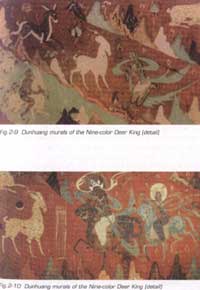In the vast desert in Northwest China, there is a small leaf-shaped oasis about 25 kilometers to the southwest of the city of Dunhuang in Gansu Province. This is where the famous Dunhuang Murals were found in the Mogao Grottos. In December 1987, Dunhuang appeared, together with Mount Tai, the Great Wall, the Forbidden City and the Terracotta Warriors, on UNESCO’s World Cultural Heritage List.
 Construction of the Mogao Grottos began in 366 and reached a peak in the Tang Dynasty (618-907), but it was not finished until the Yuan Dynasty (1279-1368). By Emperess Wuzetian’s reign in the Tang Dynasty, more than 1000 grottos had been hewn into mountain slopes there. Today, some 7,000 caves with 492 grottos remain extant in Dunhuang. The complex contains the earliest carved grotto in China. No other grottos in China have experienced a longer period of construction and have a richer content. The entire Mogao Grottos extend for 1,600 meters, and are enshrined with more than 50,000 literary documents and 45,000 square meters of murals drawn over a period that encompassed ten dynasties from the Frontal Qin Dynasty (351-394) to the Yuan Dynasty. It also features 245 colored clay sculptures, and five wooden architectural structures of the Tang and Song (907-1279) dynasties. If we put all the murals of the Dunhuang Grottos together, they would form a 25-kilometerpainting corridor, which is unique in the world.
Construction of the Mogao Grottos began in 366 and reached a peak in the Tang Dynasty (618-907), but it was not finished until the Yuan Dynasty (1279-1368). By Emperess Wuzetian’s reign in the Tang Dynasty, more than 1000 grottos had been hewn into mountain slopes there. Today, some 7,000 caves with 492 grottos remain extant in Dunhuang. The complex contains the earliest carved grotto in China. No other grottos in China have experienced a longer period of construction and have a richer content. The entire Mogao Grottos extend for 1,600 meters, and are enshrined with more than 50,000 literary documents and 45,000 square meters of murals drawn over a period that encompassed ten dynasties from the Frontal Qin Dynasty (351-394) to the Yuan Dynasty. It also features 245 colored clay sculptures, and five wooden architectural structures of the Tang and Song (907-1279) dynasties. If we put all the murals of the Dunhuang Grottos together, they would form a 25-kilometerpainting corridor, which is unique in the world.
The first painter of the Dunhuang Murals was a monk named Lezun. To create paintings on the coarse Surface of the rocks, the artists first applied grass and clay on the roofs and walls of the caves and then began painting. Several clay figures were created later to accompany the paintings. The largest mural in the grotto is 40 meters long and 30 meters wide, and the smallest less than one square meter.
Most of the Dunhuang Murals depict Buddhist stories. For example, in No. 257 Grotto, there is a mural drawn in the Northern Wei Dynasty depicting the Buddhist story “Nine-Color Deer Script.” The Nine-color Deer came upon a river and saved Diao Da who was drowning. Later the Queen urged the King to skin the Nine-color Deer to make a garment for her. When the King’s soldiers were searching for the Nine-color Deer, Diao Da betrayed the Deer’s whereabouts. Diao’s ingratitude for the Deer’s kindness was punished; the Nine-Color Deer was allowed by the King to go back to the mountain. The story is painted in nine scenes, with most animal and human figures drawn in profile; no wrinkling and rubbing skills were used to paint the background mountains and rivers. The strokes of the painting are of great strength, the colors are bright, and the shapes of the figures are decorative. Deep colors are used to draw the Outlines, and the color becomes lighter in the middle section. The brightest parts were pointed with white powders to make it look more three-dimensional.(Fig.2-9) (Fig.2-10)
The Dunhuang Murals contain rich designs of Buddhas, deities, ghosts, animals, mountains, rivers, architecture and a few decorative patterns. It is a splendid treasure of Buddhist art. The murals present the painting styles and features of different dynasties, imitating the W6stRegions at first but drawing more on the Han styles as time went on. In the Dunhuang Murals, we can see directly the development of mural art over ten dynasties and get rich information about many aspects of Chinese Culture and history.